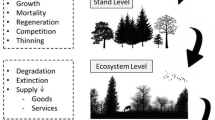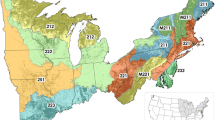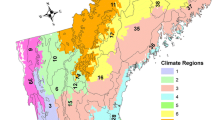Abstract
Forests provide myriad ecosystem services, many of which are vital to local and regional economies. Consequently, there is a need to better understand how predicted changes in climate will impact forest dynamics and the implications of such changes for society as a whole. Here we focus on the impacts of climate change on Indiana forests, which are representative of many secondary growth broadleaved forests in the greater Midwest region in terms of their land use history and current composition. We found that predicted changes in climate for the state—warmer and wetter winters/springs and hotter and potentially drier summers—will dramatically shape forest communities, resulting in new assemblages of trees and wildlife that differ from forest communities of the past or present. Overall, suitable habitat is expected to decline for 17–29% of tree species and increase for 43–52% of tree species in the state, depending on the region and climate scenario. Such changes have important consequences for wildlife that depend on certain tree species or have ranges with strong sensitivities to climate. Additionally, these changes will have potential economic impacts on Indiana industries that depend on forest resources and products (both timber and non-timber). Finally, we offer some practical suggestions on how management may minimize the extent of climate-induced ecological impacts and highlight a case study from a tree planting initiative currently underway in the Patoka River National Wildlife Refuge and Management Area.

Similar content being viewed by others
References
Andreadis TG, Weseloh RM (1990) Discovery of Entomophaga maimaiga in North American gypsy moth, Lymantria dispar. Proc Natl Acad Sci 87(7):2461–2465
Babin-Fenske J, Anand M (2011) Agent-based simulation of effects of stress on forest tent caterpillar (Malacosoma disstria Hubner) population dynamics. Ecol Model 222(14):2561–2569
Badè WF (1924) The life and letters of John Muir, vol I. Houghton Mifflin Company, Boston and New York, 399 pages
Bergeson SM, O'Keefe JM, Haulton GS (2018) Managed forests provide roosting opportunities for Indiana bats in south-central Indiana. For Ecol Manag 427:305–316
Blaustein RJ (2001) Kudzu’s invasion into southern United States life and culture. In: McNeeley JA (ed) The great reshuffling: human dimensions of invasive species. IUCN, The World Conservation Union, Gland, pp 55–62
Bradley BA, Wilcove DS, Oppenheimer M (2010) Climate change increases risk of plant invasion in the eastern United States. Biol Invasions 12(6):1855–1872
Brandt L, He H, Iverson L, et al. (2014) Central Hardwoods ecosystem vulnerability assessment and synthesis: a report from the Central Hardwoods Climate Change Response Framework project. Gen. Tech. Rep. NRS-124. USDA Forest Service, Northern Research Station, Newtown Square
Brandt LA, Butler PR, Handler SD, Janowiak MK, Shannon PD, Swanston CW (2017) Integrating Science and Management to Assess Forest Ecosystem Vulnerability to Climate Change. J For 115(3):212–221. https://doi.org/10.5849/jof.15-147
Bratkovich S, Burban L, Katovich S, Locey C, Pokorny J, Wiest R (1993) Flooding and its effect on trees. US Dept. of Agriculture, Forest Service, Northern Area State & Private Forestry, Misc. Publ. Newtown Square, PA
Bratkovich S, Gallion, J, Leatherberry E, Hoover W, Reading W, Durham G (2007) Forests of Indiana: their economic importance. OTHER-NA-TP-02-04 USDA Forest Service, North Central Research Station, the US Department of Commerce, the Indiana Department of Commerce, Indiana Department of Natural Resources-Division of Forestry, and Purdue University
Brzostek ER, Dragoni D, Schmid HP, Rahman AF, Sims D, Wayson CA, Johnson DJ, Phillips RP (2014) Chronic water stress reduces tree growth and the carbon sink of deciduous hardwood forests. Glob Chang Biol 20:2531–2539
Butler AW (1896) Indiana: a century of changes in the aspects of nature. Proc Indiana Acad Sci 5:31–42
Byers DL, Quinn JA (1998) Demographic variation in Alliaria petiolata (Brassicaceae) in four contrasting habitats. J Torrey Bot Soc 125(2):138–149
Caignard T, Kremer A, Firmat C, Nicolas M, Venner S, Delzon S (2017) Increasing spring temperatures favor oak seed production in temperate areas. Sci Rep 7:8555
Carter TC, Feldhamer GA (2005) Roost tree use by maternity colonies of Indiana bats and northern longeared bats in southern Illinois. For Ecol Manag 219:259–268
D’Orangeville, L., Maxwell, J., Kneeshaw, D., Pederson, N., Duchesne, L., Logan, T., Houle, D., Arseneault, D., Beier, C.M., Bishop, D.A., ,Druckenbrod, D., Fraver, S., Girard, F., Halman, J., Hansen, C., Hart, J.L., Hartmann, H., Kaye M., Leblanc, D., Manzoni, S., Rayback, S., Rollinson, C., R.P. Phillips (2018) Local climate and drought timing determine the sensitivity of eastern temperate forests to drought. Glob Chang Biol 24: 2339-2351
DiTomaso JM (2000) Invasive weeds in rangelands: species, impacts, and management. Weed Sci 48:255–265
Dukes JS, Pontius J, Orwig D, Garnas JR, Rodgers VL, Brazee N, Cooke B, Theoharides KA, Stange EE, Harrington R, Ehrenfeld J, Gurevitch J, Lerdau M, Stinson K, Wick R, Ayres M (2009) Responses of insect pests, pathogens, and invasive plant species to climate change in the forests of northeastern North America: What can we predict? Can J For Res 39:231–248
Dunn PO, Winkler DW (1999) Climate change has affected the breeding date of tree swallows throughout North America. Proc R Soc Lond Biol 266:2487–2490
Evans TP, Kelley H (2008) Assessing the transition from deforestation to forest regrowth with an agent based model of land cover change for South-Central Indiana (USA). Geoforum 39:819–832
Fei S, Steiner KC (2007) Evidence for increasing red maple abundance in the eastern United States. For Sci 53:473–477
Fei S, Kong N, Steiner KC, Moser WK, Steiner EB (2011) Change in oak abundance in the eastern United States from 1980 to 2008. For Ecol Manag 262:1370–1377
Fei S, Desprez JM, Potter KM, Jo I, Knott JA, Oswalt CM (2017) Divergence of species response to climate change. Sci Adv 3(5):e1603055
Francl LJ (2001) The disease triangle: a plant pathological paradigm revisited. Plant Health Instructor. https://doi.org/10.1094/PHI-T-2001-0517-01
Gibson DJ, Spyreas G, Benedict J (2002) Life history of Microstegium vimineum (Poaceae), an invasive grass in southern Illinois. J Torrey Bot Soc 129:207–219
Gormanson DD, Kurtz CM (2017) Forests of Indiana (2016) Resource update FS-127. USDA Forest Service Northern Research Station, Newtown Square. https://doi.org/10.2737/FS-RU-127
Hamlet A, Byun K, Robeson S, Widhalm M, Baldwin M (2018) Impacts of Climate Change on the State of Indiana: Future Projections Based on CMIP5. Clim Chang. [note, this publication is part of the same special issue]
Harrington TC, McNew D, Yun HY (2012) Bur oak blight, a new disease on Quercus macrocarpa caused by Tubakia iowensis sp. nov. Mycologia 104:79–92
Hicke JA, Allen CD, Desai AR et al. (2011) Effects of biotic disturbances on forest carbon cycling in the United States and Canada. Glob Chang Biol 18(1):7–34
Iannone BV, Oswalt CM, Liebhold AM, et al. (2015) Region-specific patterns and drivers of macroscale forest plant invasions. Divers Distrib 21:1181–1192
Indiana Department of Natural Resources (INDNR) (2005) Indiana logging and forestry best management practices. 2005 BMP field guide. https://www.in.gov/dnr/forestry/2871.htm
Indiana Geological Survey (2001) 2001 Land Cover in Indiana, Derived from the National Land Cover Database (NLCD) (United States Geological Survey, 30-Meter Grid), digital representation by Chris Dintaman, 2007
Iverson LR, Prasad AM, Matthews SN, Peters M (2008) Estimating potential habitat for 134 eastern US tree species under six climate scenarios. For Ecol Manag 254:390–406
Iverson LR, Thompson FR, Matthews S, Peters M, Prasad A, Dijak WD, Fraser J, Wang WJ, Hanberry B, He H, Janowiak M (2017) Multi-model comparison on the effects of climate change on tree species in the eastern US: results from an enhanced niche model and process-based ecosystem and landscape models. Landsc Ecol 32(7):1327–1346
Janowiak MK, Swanston CW, Nagel LM, et al. (2014) A practical approach for translating climate change adaptation principles into forest management actions. J For 112(5):424–433
Jarnevich C, Stohlgren T (2009) Near term climate projections for invasive species distributions. Biol Invasions 11(6):1373–1379
Lesk C, Coffe E, D’Amato AW, Dodds K, Horton R (2017) Threats to North American forests from southern pine beetle with warming winters. Nat Clim Chang 7(10):713
Lindsey AA, Crankshaw WB, Qadir SA (1965) Soil Relations and Distribution Map of the Vegetation of Presettlement Indiana. Bot Gaz 126(3):155–163
Logan JA, Régnière J, Gray DR, Munson AS (2007) Risk assessment in the face of a changing environment: gypsy moth and climate change in Utah. Ecol Appl 17(1):101–117
Maher SP, Kramer AM, Pulliam JT, et al. (2012) Spread of white-nose syndrome on a network regulated by geography and climate. Nat Commun 3:1306
Matthews S, Iverson L (2017) Managing for delicious ecosystem service under climate change: can United States sugar maple (Acer saccharum) syrup production be maintained in a warming climate? Int J Biodivers Sci Eco Serv Manag 13(2):40–52
Mech AM, Tobin PC, Teskey RO, Rhea JR, Gandhi KJ (2018) Increases in summer temperatures decrease the survival of an invasive forest insect. Biol Invasions 20:365–374
Moran EF, Ostrom E (2005) Seeing the forest and the trees: human-environment interactions in forest ecosystems. MIT Press, Cambridge
Nagel LM, Palik BJ, Battaglia MA, et al. (2017) Adaptive Silviculture for climate change: a national experiment in manager-scientist partnerships to apply an adaptation framework. J For 115(3):167–178
National Atmospheric Deposition Program (NRSP-3) (2018) NADP Program Office, Wisconsin State Laboratory of Hygiene, Madison. Available at http://www.natureserve.org/explorer. Accessed 11 Feb 2013
Nearing MA (2001) Potential changes in rainfall erosivity in the U.S. with climate change during the 21st century. J Soil Water Conserv 56(3):229–232
Nearing MA, Pruski FF, O’Neal MR (2004) Expected climate change impacts on soil erosion rates: a review. J Soil Water Conserv 59(1):43–50
Nicholls S (2012) Outdoor recreation and tourism. In: Winkler J, Andresen J, Hatfield J, Bidwell D, Brown D (eds) US National Climate Assessment Midwest technical input report. Available at http://glisa.msu.edu/docs/NCA/MTIT_RecTourism.pdf. Accessed 15 May 2013
Nowacki GJ, Abrams MD (2008) The demise of fire and “mesophication” of forests in the eastern United States. BioSci 58(2):123–138
Oliver TH, Morecroft MD (2014) Interactions between climate change and land use change on biodiversity: attribution problems, risks and opportunities. Clim Chang 5:317–335
Ostfeld RS, Canham CD, Oggenfuss K, Winchcombe RJ, Keesing F (2006) Climate, deer, rodents, and acorns as determinants of variation in Lyme-disease risk. PLoS Biol 4(6):0040145
Oswalt CM, Fei S, Guo Q, et al. (2015) A subcontinental view of forest plant invasions. NeoBiota 24:49–54
Park J-H, Juzwik J, Cavender-Bares J (2013) Multiple Ceratocystis smalleyi infections associated with reduced stem water transport in bitternut hickory. Phytopathology 103(6):565–574
Parker GR (1997) The wave of settlement. In: Jackson MT (ed) The natural heritage of Indiana. Indiana University Press, Bloomington, pp 369–382
Parker GR, Ruffner CM (2004) Current and historical forest conditions and disturbance regimes in the Hoosier–Shawnee ecological assessment area. In: Thompson, FR III (ed) The Hoosier–Shawnee ecological assessment. Gen. Tech. Rep. NC-244. USDA Forest Service, North Central Research Station, St. Paul, p 23–58
Pearson RG, Stanton JC, Schoemaker KT, (2014) Life history and spatial traits predict extinction risk due to climate change. Nat Clim Chang 4:217–221
Phillips RP, Midgley MG, Brzostek E (2013) The mycorrhizal-associated nutrient economy: A new framework for predicting carbon-nutrient couplings in forests. New Phytol 199:41–51
Prasad AM, Iverson LR, Peters MP, Matthews SN (2014) Climate change tree atlas. Northern Research Station, US Forest Service, Delaware. http://www.nrs.fs.fed.us/atlas
Ridgway R (1972) Notes on the vegetation of the Lower Wabash Valley. Am Nat 6:724–732
Simberloff D (2000) Global climate change and introduced species in United States forests. Sci Total Environ 262:253–261
Skinner CB, DeGaetano AT, Chabot BF (2010) Implications of twenty-first century climate change on northeastern United States maple syrup production: impacts and adaptations. Clim Chang 100(3-4):685–702
Soula S (2009) Lightning and precipitation. In: Betz HD, Schumann U, Laroche P (eds) Lightning: principles, instruments and applications. Springer, Dordrecht
Swanston CW, Janowiak MK, Brandt LA, et al. (2016) Forest adaptation resources: climate change tools and approaches for land managers, 2nd ed. NRS-GTR-87-2. USDA Forest Service, Northern Research Station, Newtown Square. https://doi.org/10.2737/NRS-GTR-87-2
Thomson AM, Calvin KV, Smith SJ, Kyle GP, Volke A, Patel P, Delgado-Arias S, Bond-Lamberty B, Wise MA, Clarke LE (2011) RCP4. 5: a pathway for stabilization of radiative forcing by 2100. Clim Chang 109:77
Ungerer MJ, Ayres MP, Lombardero M (1999) Climate and the northern distribution limits of Dendroctonus frontalis Zimmermann (Coleoptera: Scolytidae). J Biogeogr 2:1133–1145
US Department of the Interior, US Fish and Wildlife Service, and US Department of Commerce, US Census Bureau (2011) National survey of rishing, hunting, and wildlife-associated recreation. Available at https://www.census.gov/prod/2013pubs/fhw11-in.pdf. Accessed 22 Feb 2018
US Forest Service (1985) Insects of eastern forests. Misc. Publ. 1426. Washington, DC, USDA Forest Service
US Forest Service (2006) Final environmental impact statement, land and resource management plan Hoosier National Forest. Bedford, Hoosier National Forest
van Vuuren DP, Edmonds J, Kainuma M et al (2011) The representative concentration pathways: an overview. Clim Chang 109:5
Walters BF, Settle J, Piva RJ (2012) Indiana timber industry: an assessment of timber product output and use, 2008. Resour Bull NRS-63. USDA Forest Service, Northern Research Station, Newtown Square
Webster CR, Rock JH, Froese RE, Jenkins MA (2008) Drought–herbivory interaction disrupts competitive displacement of native plants by Microstegium vimineum, 10-year results. Oecologia 157(3):497-508
Zollner PA, Smith WP, Brennan LA (2000) Home range use by swamp rabbits (Sylvilagus aquaticus) in a frequently inundated bottomland forest. Am Midl Nat 143:64–69
Acknowledgements
We thank guest editor Jeff Dukes and two anonymous reviewers who provided helpful feedback on the manuscript. We also thank Stephen Shifley and many stakeholders for reviewing and commenting on earlier versions. We are indebted to several other members of the Northern Institute of Applied Climate Science, including Matthew Peters, Anantha Prasad, and Steven Matthews, for their assistance in preparing data for this project.
Author information
Authors and Affiliations
Corresponding author
Additional information
Publisher’s Note
Springer Nature remains neutral with regard to jurisdictional claims in published maps and institutional affiliations.
This article is part of a Special Issue on “The Indiana Climate Change Impacts Assessment” edited by Jeffrey Dukes, Melissa Widhalm, Daniel Vimont, and Linda Prokopy.
Richard P. Phillips and Leslie Brandt contributed equally to this work.
Electronic supplementary material
ESM
(DOCX 20.7 kb)
Rights and permissions
About this article
Cite this article
Phillips, R.P., Brandt, L., Polly, P.D. et al. An integrated assessment of the potential impacts of climate change on Indiana forests. Climatic Change 163, 1917–1931 (2020). https://doi.org/10.1007/s10584-018-2326-8
Received:
Accepted:
Published:
Issue Date:
DOI: https://doi.org/10.1007/s10584-018-2326-8




